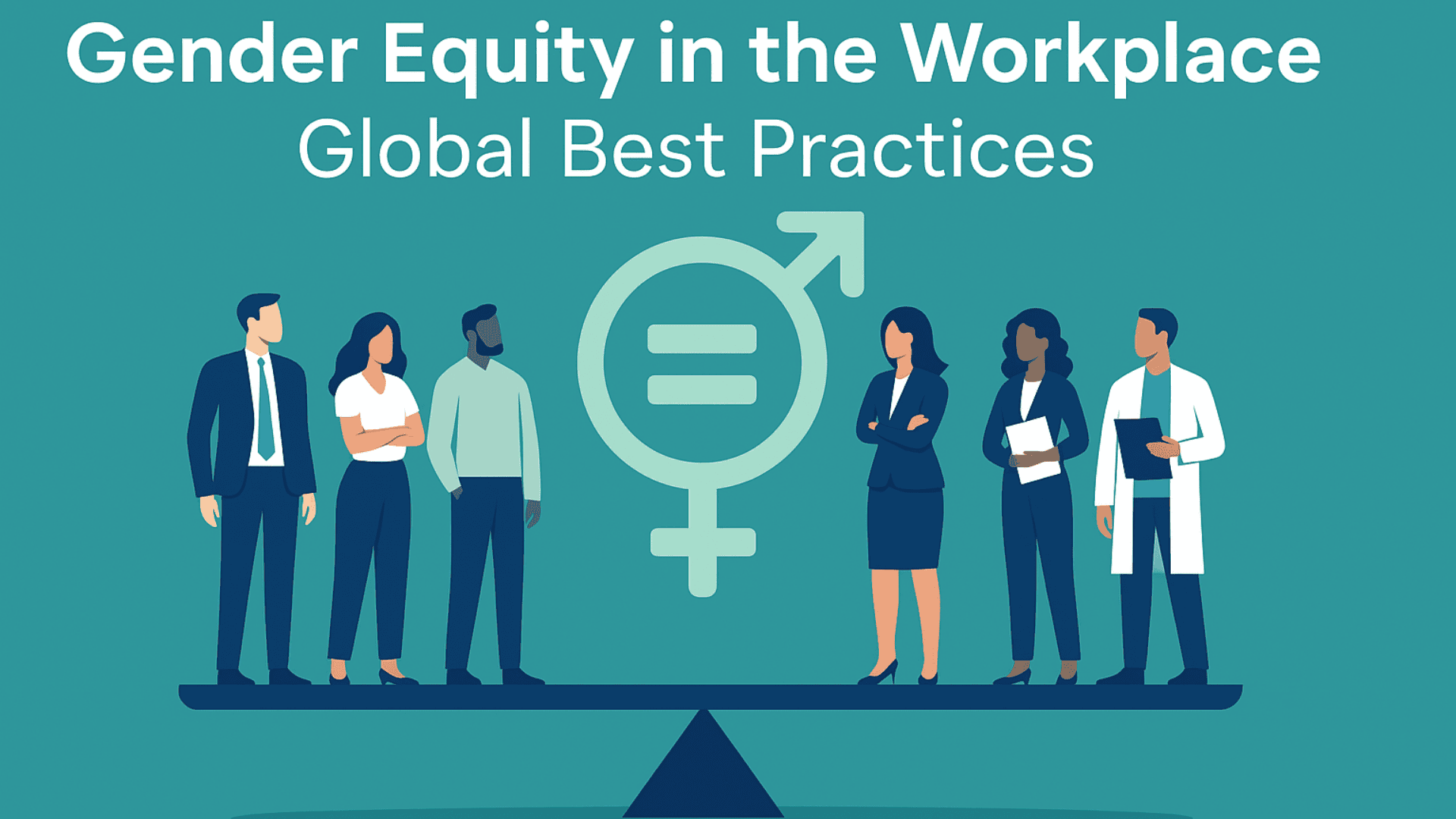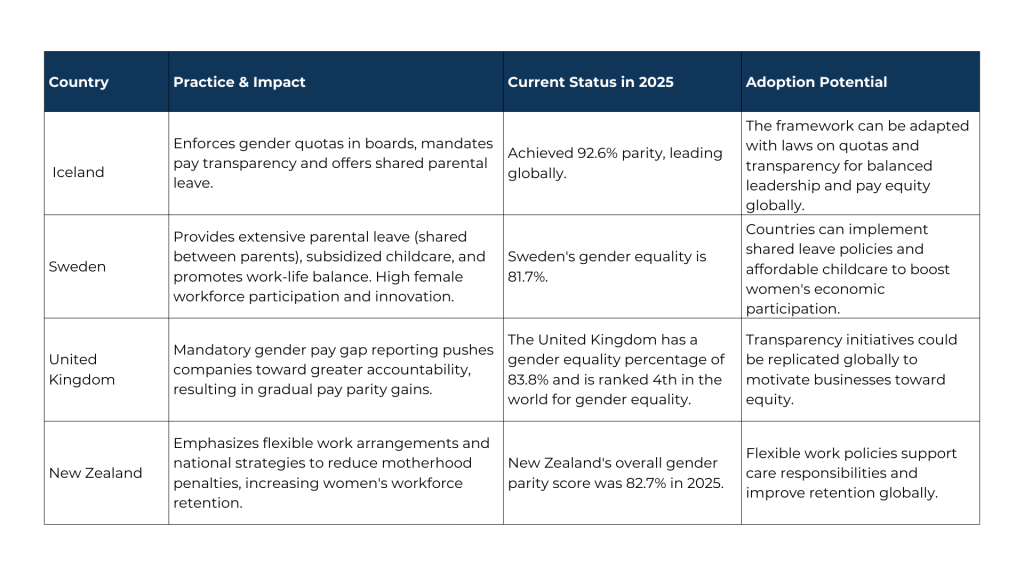
27 Nov Gender Equity in the Workplace: Global Best Practices
Gender equity remains a global challenge today, with the latest 2025 Global Gender Gap Report by the World Economic Forum indicating that only 68.8% of the overall gender gap has been closed worldwide. This means full gender parity is still estimated to take about 123 years at the current pace. Notably, Iceland leads for the 16th consecutive year, closing 92.6% of its gender gap, while countries like Pakistan and Sudan rank among the lowest, with scores under 57% parity.
Why Gender Equity Matters in the Workplace
Gender equity is essential for fairness, economic efficiency, and societal well-being. Diverse workplaces that embrace gender equity benefit from broader perspectives, increased innovation, and enhanced decision-making. Economically, narrowing gender gaps could add trillions of dollars annually to global GDP. Equity in pay, leadership, and opportunities also reflects fundamental human rights principles.
Women participate in the global workforce at about 47%, compared to 72% for men, and hold less than one-third of senior roles. Regions like Northern Europe and Latin America lead in closing gaps, while South Asia and the Middle East lag behind.

Source: Global Gender Gap Report, 2006-2024
Despite notable progress in women’s labor-market participation and leadership roles, persistent structural barriers continue to sustain a gender gap in the workplace. Globally, women accounted for 41.2% of the workforce in 2024, rising from around 39.3% in 2015. However, their representation in top leadership remains markedly lower: in the same period, the share of women in top-management roles increased only from 25.7% in 2015 to 28.1% in 2024.

Source: LinkedIn Economic Graph
Moreover, the overall global gender‐gap closure rate stood at just 68.8% in 2025, implying full parity is still more than a century away at current speeds of change. These figures illustrate that while entry participation is improving, the “glass ceiling” and leadership pipeline leaks remain critical obstacles. The consequence is an underutilization of female talent, which, according to the World Bank, could cost economies over 20 % in potential GDP growth. Closing the gender gap in the workplace is not only a matter of social justice, but also a strategic economic imperative; doing so will require accelerating advancement in leadership roles, ensuring equitable access, and eliminating segregation into lower-paying sectors.
Best Practices from Countries: Lessons and Adoption Potential

Explaining the Table and Its Broader Implications
- Iceland’s Model: Iceland’s legal requirement for gender quotas on corporate boards and pay transparency directly combats structural bias, resulting in one of the world’s smallest gender gaps. In 2018, Iceland became the first country to legally require companies to prove equal pay for equal work. Since 2021, each parent has received six months of paid parental leave. Parents can transfer six weeks of their entitlement to the other, creating individual quotas that incentivize fathers to use their leave. Other countries can replicate this framework by legislating gender balance and mandating pay equity reporting, which have proven to drive gender parity effectively.
- Family-Centric Policies in Sweden: Sweden’s extensive parental leave system, shared equally between parents, and its subsidized childcare infrastructure remove significant barriers women face in balancing career and family life. The Swedish parental insurance system includes 480 days of paid leave per child, 90 days of which are reserved for each parent, encouraging both to take time off. Such policies enable higher female labor participation and spur business innovation by retaining talent, which has helped Sweden to achieve gender equality rate of 81.7%. Nations can adopt these policies to reduce the “care penalty” that women disproportionately bear.
- Transparency in the UK: The UK’s binding mandate for companies to report gender pay gaps publicly creates pressure for change through visibility. Transparency makes inequities undeniable and incentivizes organizations to take corrective action. The proportion of women in the House of Commons has been steadily increasing, reaching 40.5% in 2024. The current cabinet is also the most gender-equal in British history. Other nations can encourage gender parity by implementing mandatory reporting and establishing clear consequences for non-compliance.
- New Zealand’s Flexible Work Policies: By addressing the motherhood penalty through national strategies and fostering flexible work environments, New Zealand helps women stay and succeed in the workforce. The government’s Te Mahere Whai Mahi Wāhine Women’s Employment Action Plan focuses on issues that are barriers to women’s work, including pay equity and access to childcare. It targets diverse groups of women, including Māori, Pacific, and solo mothers. Flexible hours and remote options can be widely adopted to accommodate caregiving demands, reducing dropout rates among working mothers globally.
Conclusion
The global gender gap remains sizable, but actionable insights from leading countries show how legal mandates, family-friendly policies, transparency, and cultural shifts foster more equitable workplaces. Adopting best practices suited to national contexts can accelerate progress. Countries seeking gender equity should tailor and combine these proven approaches to close gaps faster than the daunting 123-year projection, fostering inclusive economies and societies for all.
Blog by Shreya Ghimire,
Research Analyst, Frost & Sullivan Institute
